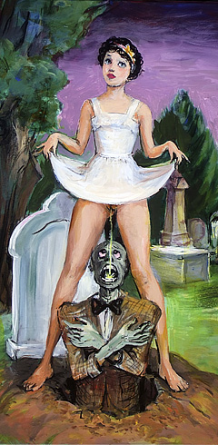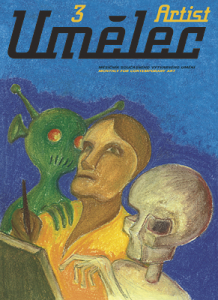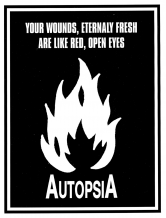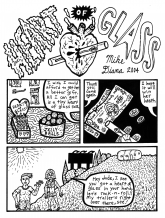| Umělec 2008/2 >> Post-War Dreams from Sarajevo | Просмотр всех номеров | ||||||||||||
|
|||||||||||||
Post-War Dreams from SarajevoUmělec 2008/201.02.2008 Michal Koleček | illumination | en cs de es |
|||||||||||||
|
Interview with Šejla Kamerić by Michal Koleček on the occasion of her solo show at Emil Filla Gallery in Ústí nad Labem.
Šejla, you currently live in Berlin. Could you describe or compare an artist’s position within “Western” and “Eastern” societies? I was able to move to Berlin thanks to the DAAD Artist in Residency Fellowship I recieved in 2007. My decision to come here was pragmatic, like many other artists from all over the world. Berlin deliberately attracted artists, thus creating sort of a cluster. It is indeed a unique situation, which makes the artist’s position in it very inspirational, but not exactly a representative example of an artist’s position in “Western society” in general. Could you describe the contemporary institutional structure for visual art in Sarajevo? There are quite a few institutions that deal with visual arts in Sarajevo, but there has never been an articulated cultural policy to support their activities. Each of these institutions is actually struggling to survive today, mainly due to financial difficulties. It is quite a sad situation and what makes it even worse is the fact that individual initiatives cannot solve the problem; it is up to a wider political solidarity, which has proven to be very hard to achieve in current Bosnian political reality. Do you still cooperate with any institutions in Sarajevo? I have a very close connection with the Sarajevo Center of Contemporary Art and their production studio pro.ba. I’m grateful to SCCA and Dunja Blazevic for they support over the years. They are working in very difficult, almost humiliating conditions but they are still extremely supportive of the artists and filmmakers in Bosnia and Herzegovina. Could you compare the current situation of Bosnian art with the early post-war period (2nd half of 1990s)? Before we were more excluded and exclusive thanks to the war. Today quite a few B&H artists are present on the international art scene, but not much is done “back home” to support them and more importantly support the emergence of new talents. In your art projects it is often possible to see principles of documentarism. Could you describe the way that you connect “real” material with the aesthetical structure and poetics in your artworks? I dislocate the “real” material to a new environment or context and in that way I try to expose it to different readings. Often, it is the simplest way that creates the strongest sensation. Before I called it a “copy-paste” method, now I think of it as “re-membering.” It is very much like imagining something, as if it is a memory you have. The essence remains; one thing is enough to bring back forgotten emotions. Imagination is filling the gaps that memories contain. Your works are known for usage of cinematic effects and profiles. Where do you feel the borderline between film-making and video-art is? Is this comparison important for you? Simply, I don’t care about these borders in art. I don’t see a reason to be strict in defining different media in art, as it is not about competition or even comparison. I love film and of course that has influenced my work. It is exciting to use various tools and languages to capture emotions and tell stories and in that way reach wider audiences. The theme of “scars” is frequented in your recent works. Could you explain the switch-over from the direct artistic reaction to certain social mechanisms to the more intimate strategy, which is focused on their emphatic reflection? The scars are painful reminders, when they are in the memories it is hardly possible to erase them. To confront the cause it is sometimes enough to show the consequences. My approach might seem different but it is still very direct reaction to a certain issue. A story-telling moment (narrative line) is presented in your piece “Wall”, which was exhibited in Ústí nad Labem. How do you deal with the connection between the given story and its interpretation, which is influenced by the time distance and social conditions (which could change the meaning of the story or make it clearer and more accurate)? The starting point for this piece was remembering Leonid Andrejev’s story “The Wall” that I read as a teenager before the war in Yugoslavia. The way the story changed in my memory and how much it became part of my later experience was the key for the reinterpretation. I asked the actors to adopt this story as their own and to try to relive it instead of just telling it. Their reaction was instinctive. The actors connected the given story to their own memories. The story became true because the emotions they gave were honest. In the piece “We were chilling by the pool, when the war started” you use an ordinary image in connection with significant title of the artwork. Could you tell me, how the textual moment is important for the structure of the art project in this case? The image was taken in Jerusalem in 2005 when Israel invaded Lebanon over the Hezbollah kidnapping two of their soldiers. Before taking the photo I had this sentence. It was the exact information, the reality that seemed so unreal. Without the text this work would not exist. I feel that your artworks Red and Green involve an ambivalent connotation of human desire for self-promotion and tragic self-destruction, as well. Could you interpret this moment? (In relation to the social situation of post-war society in Balkan countries?) “As signifying beings, we leave marks in our world and thus create our cultures. These marks range from: images and sounds to wounds and scars.”(*) In the artworks Red and Green I offer documentation of human behavior. I recognize the scars that are overlooked as minor but that are still direct evidence of destruction. In a post-war society those scars are enhanced but they can be found everywhere. Your public-art project titled EU citizens / Others, installed in Ljubljana at Plecnik's Three Bridges (one of the most important modernist architecture monuments in the region of former Yugoslavia) was focused on the reflection of divided Europe. Do you feel that your position – as a citizen, woman and artist – from the “East” has changed in the frame of European Union over the last eight years? In fact my position has not changed. The piece I made for Manifesta 3 in Ljubljana was about segregation. Thanks to political correctness signs the formerly read “Others” have been changed to signs that say “Non EU Citizens.” That is the biggest change I see. * Blue, Red & Green, Damir Arsenijević June - July 2008
01.02.2008
Рекомендуемые статьи
|
|||||||||||||
|
04.02.2020 10:17
Letošní 50. ročník Art Basel přilákal celkem 93 000 návštěvníků a sběratelů z 80 zemí světa. 290 prémiových galerií představilo umělecká díla od počátku 20. století až po současnost. Hlavní sektor přehlídky, tradičně v prvním patře výstavního prostoru, představil 232 předních galerií z celého světa nabízející umění nejvyšší kvality. Veletrh ukázal vzestupný trend prodeje prostřednictvím galerií jak soukromým sbírkám, tak i institucím. Kromě hlavního veletrhu stály za návštěvu i ty přidružené: Volta, Liste a Photo Basel, k tomu doprovodné programy a výstavy v místních institucích, které kvalitou daleko přesahují hranice města tj. Kunsthalle Basel, Kunstmuseum, Tinguely muzeum nebo Fondation Beyeler.
|



































 We Are Rising National Gallery For You! Go to Kyjov by Krásná Lípa no.37.
We Are Rising National Gallery For You! Go to Kyjov by Krásná Lípa no.37.
Комментарии
Статья не была прокомментированаДобавить новый комментарий